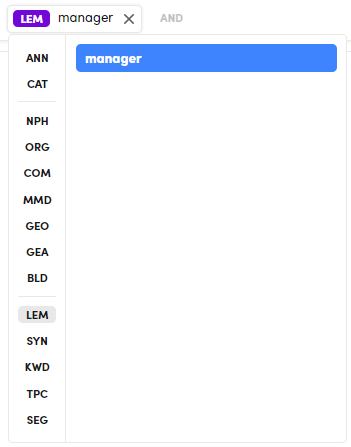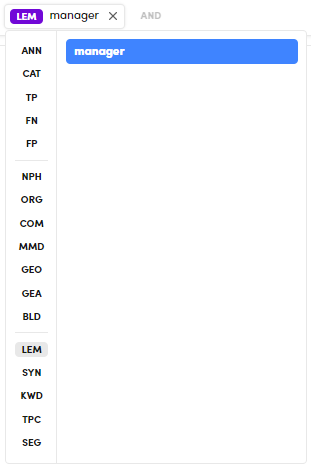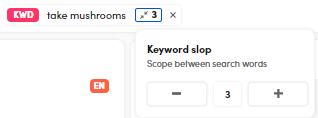The search bar
Overview
The search bar is a tool common to all the views of the Documents tab except immersive detail views.

Through it you can set and apply search criteria to filter the documents of the current library or corpus.
You can compose the search criteria both by typing and by selecting data from the other panels (see below).
You can select the language of the documents by selecting Search bar language on the left of the bar.
To activate the search, press Enter or select Run search  .
.
After the first search, results are updated automatically with each change—addition, replacement, deletion—of the criteria.
To reset the search, select the X icon  to the right of the search bar.
to the right of the search bar.
Operand boxing
What you type, when you make a a pause, is automatically enclosed in a box corresponding to a type of element that the system guesses.
For example, if you type theo and pause, the system will assume that it is a keyword and encapsulate the word in a box prefixed by the KWD chip.

If, on the other hand, you type theory and pause, the system may consider it to be a lemma.

To change the value on an element, put the cursor inside and edit it.
If you delete all the characters inside a box and you press Backspace at a fast pace, the entire box will be removed.
To delete an element of the search criteria, select the X icon inside the element box.
Hints
You can change both the element's type and its value using system hints. To see the hints, click on the colored chip inside the element's box.
A menu appears showing possible element types, including annotations and project resources—categories, classes, concepts, depending on the project type—which, in case there is an experiment in context, are searchable features of documents.

In the hints menu, experiment results are labeled CAT in the case of categories (categorization projects) or EXT in the case of extractions (for extraction projects and thesaurus projects).
Annotations are labeled ANN. For the labels of named entity types and tokens see the reference section of this manual.
Additional experiment result labels are added when an experiment is selected from its document statistics page.
Such labels are:
- TP to search for the value as a true positive.
- FP to search for the value as a false positive.
- FN to search for the value as a false negative.

More information about document statistics here:
- Document statistics for categorization experiments.
- Document statistics for extraction experiments.
- Document statistics for thesaurus experiments.
Values may or may not be suggested for each element type. To use a suggested value and replace the current element, just select the value.
Boolean operators
The search criteria can be as simple as a single boxed element or a Boolean expression of multiple elements combined with AND, OR and NOT operators.
To add a boolean operator, click to the right of the last boxed element. The default Boolean operator is AND.

To toggle between AND and OR, select the operator.
Note
A pending Boolean operator at the end of the expression does not affect the search criteria and search results.
To add a NOT operatore type the exclamation point (!). A gray box is created in which you can write an element.


In case of multiple lemmas and boolean operators involved in your search, you can use round brackets to modify the default evaluation order of boolean operators for more precise searches.
For example, a search like this:

filters the document list to 5 documents.
The same search with round brackets like this:

filters the document list to 1 document.
Element codes
Instead of letting the system guess the type of element, you can enforce it by typing in its code.
Element type codes are listed under the ellipsis menu  , which you can use as a reference, but from which you can also pick a code, thus avoiding typing it.
, which you can use as a reference, but from which you can also pick a code, thus avoiding typing it.
When you type the code of an element type or choose it from the ellipsis menu, the system creates an empty box of that type.


You can then type the value of the element into the box.

You can also change the type of an element using the ellipsis menu:
- Click on the item's value.
- Choose the new type from the ellipsis menu.
Keyword slop
When the value of a keyword type element includes several words, you can adjust the slop, that is the tolerance in terms of distance in words between the words typed. Value 1 means that the words must be one after the other.

Picking elements from other panels
The values of the various facets in the list view, the most relevant terms shown above the list of documents, also in the list view, the main topics in the detail view and the values of the document properties in the right panel of the same view can all be used as search criteria.
To do this, just double-click the value. A new search taking is immediately triggered.